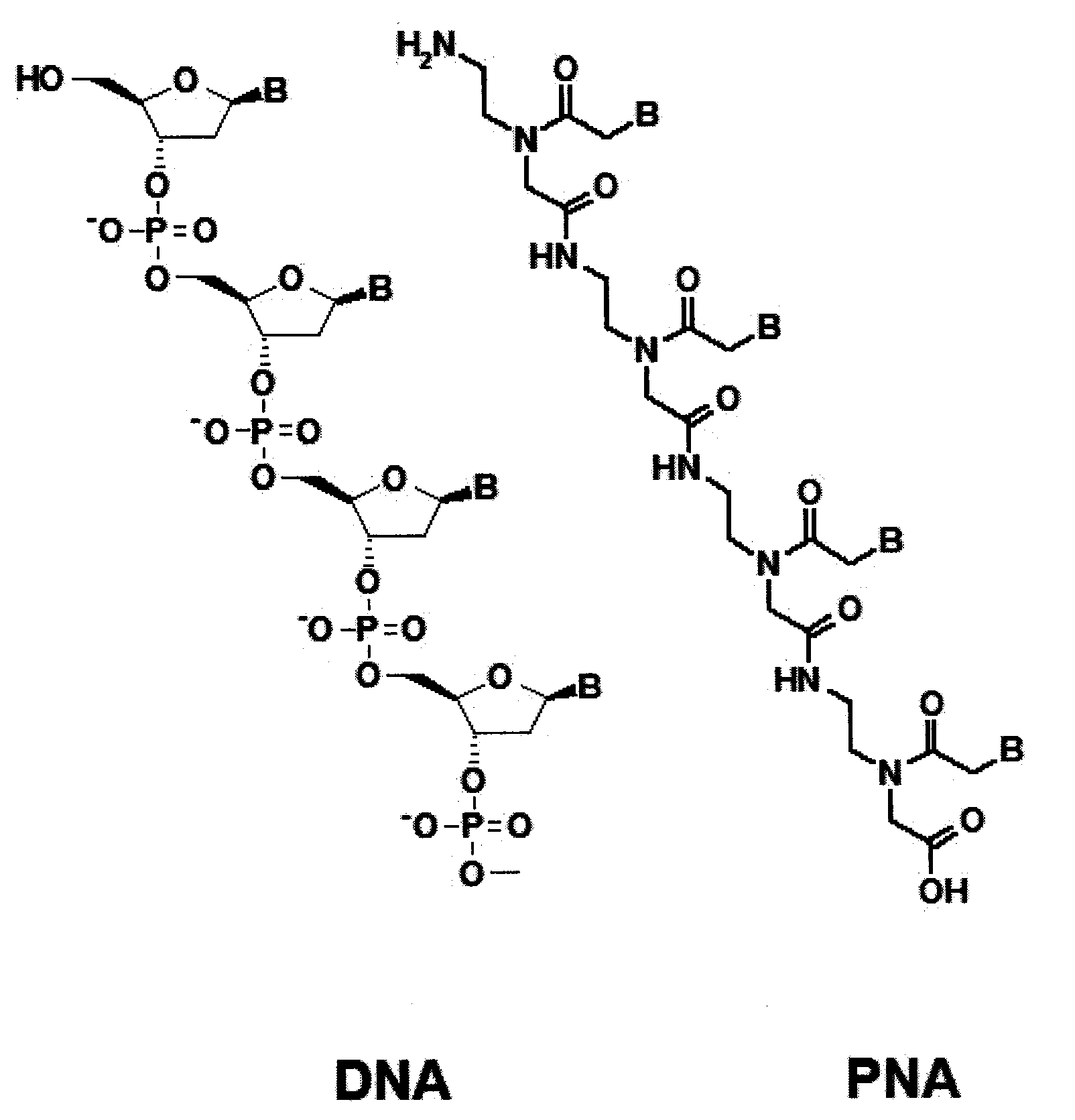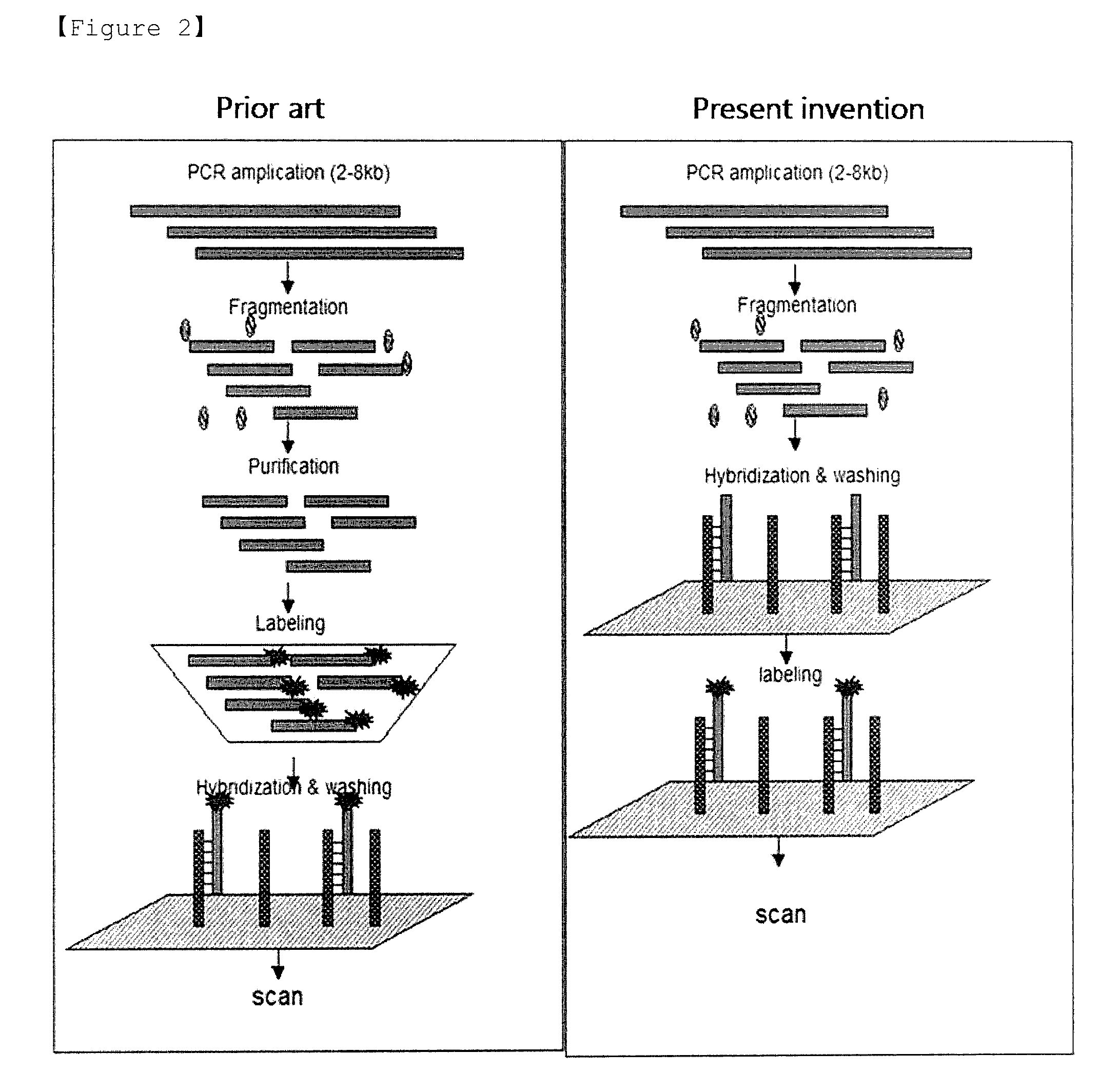Method for Selective Labeling and Detection of Target Nucleic Acids Using Immobilized Peptide Nucleic Acid Probes
a technology probes, which is applied in the field of selective labeling and detection of target nucleic acids using nucleic acid analogue probes, can solve the problems of reducing the efficiency of pcr, difficult to detect nucleic acids in a state of nature, and monomers labeled with fluorophores
- Summary
- Abstract
- Description
- Claims
- Application Information
AI Technical Summary
Benefits of technology
Problems solved by technology
Method used
Image
Examples
example 2
Mutagenesis and Cloning for Preparing Target Nucleic Acids
[0089]Nucleic acids were amplified from human total DNA with each primer, and the amplified nucleic acids were ligated to pGEM-T easy vector (Promega, USA). E. coli JM 109 cells were transformed with the vector to produce DNA at a large amount.
[0090]The DNA was sequenced and confirmed to have no mutation, to obtain normal DNA clones.
[0091]To obtain clones having mutant genes affecting drug metabolism, mutation was induced for the normal clones obtained above by using Stratagene mutagenesis kit (Promega, USA), to obtain clones having mutant genes.
example 3
Preparation of Target Nucleic Acids by PCR with Primers
[0092]The normal DNA and the mutant DNA cloned above were used as template DNA, respectively. The DNAs were amplified by PCR with each primer as shown in the above Table 2, in the following condition:
[0093]Treatment at 94° C. for 5 minutes; 35 cycles of denaturation at 94° C. for 1 minute, annealing at 62° C. for 1 minute, and extension at 72° C. for 6 minutes; followed by final extension at 72° C. for 7 minutes, in the composition of 2 μl of template DNA solution (50 ng / μl), 1 μl of each sense primer (20 μmol / μl) and 1 μl of each antisense primer (20 pmol / μl) as shown in Table 2, 3 μl of dNTP (25 mM), 5 μl of 10×Taq buffer containing MgCl2, 5 μl of Band Doctor (Solgent Co., Ltd., Korea), 0.2 μl of Taq (5 U / μl, Solgent Co., Ltd., Korea) and 36.8 μl of distilled water.
[0094]Upon completion of the reaction, to 5 U / μl of the PCR product (1.9 kb, 2.7 kb, 4.4 kb) was added 1 μl of gel loading buffer (Sunbio, Co., Ltd., Korea) followe...
example 4
Construction of a PNA Chip
[0095]The purified PNA oligomers represented by SEQ. ID Nos. 1 to 8, as shown in Table 1, were diluted to 50 mM in PNAArray™ spotting buffer (50 mM, Panagene, Korea), and spotted on an epoxy coated glass slide in a pin mode. It was allowed to stand at room temperature while maintaining a relative humidity of 75% for 4 hours. Then, the slide was introduced into DMF (dimethyl formamide), and washed by ultrasonication for 15 minutes. The slide was introduced into DMF containing 0.1 M succinic unhydride, followed by reaction at 40° C. for 2 hours to remove residual amine group. The slide was washed with DMF for 15 minutes, and washed by ultrasonication with deionized water for 15 minutes. 100 mM Tris-HCl containing 0.1 M ethanolamine was added thereto, followed by reaction at 40° C. for 2 hours to inactivate residual epoxy group on the solid surface. The slide was washed with deionized water for 5 minutes, and then, dried.
PUM
 Login to View More
Login to View More Abstract
Description
Claims
Application Information
 Login to View More
Login to View More - R&D
- Intellectual Property
- Life Sciences
- Materials
- Tech Scout
- Unparalleled Data Quality
- Higher Quality Content
- 60% Fewer Hallucinations
Browse by: Latest US Patents, China's latest patents, Technical Efficacy Thesaurus, Application Domain, Technology Topic, Popular Technical Reports.
© 2025 PatSnap. All rights reserved.Legal|Privacy policy|Modern Slavery Act Transparency Statement|Sitemap|About US| Contact US: help@patsnap.com



